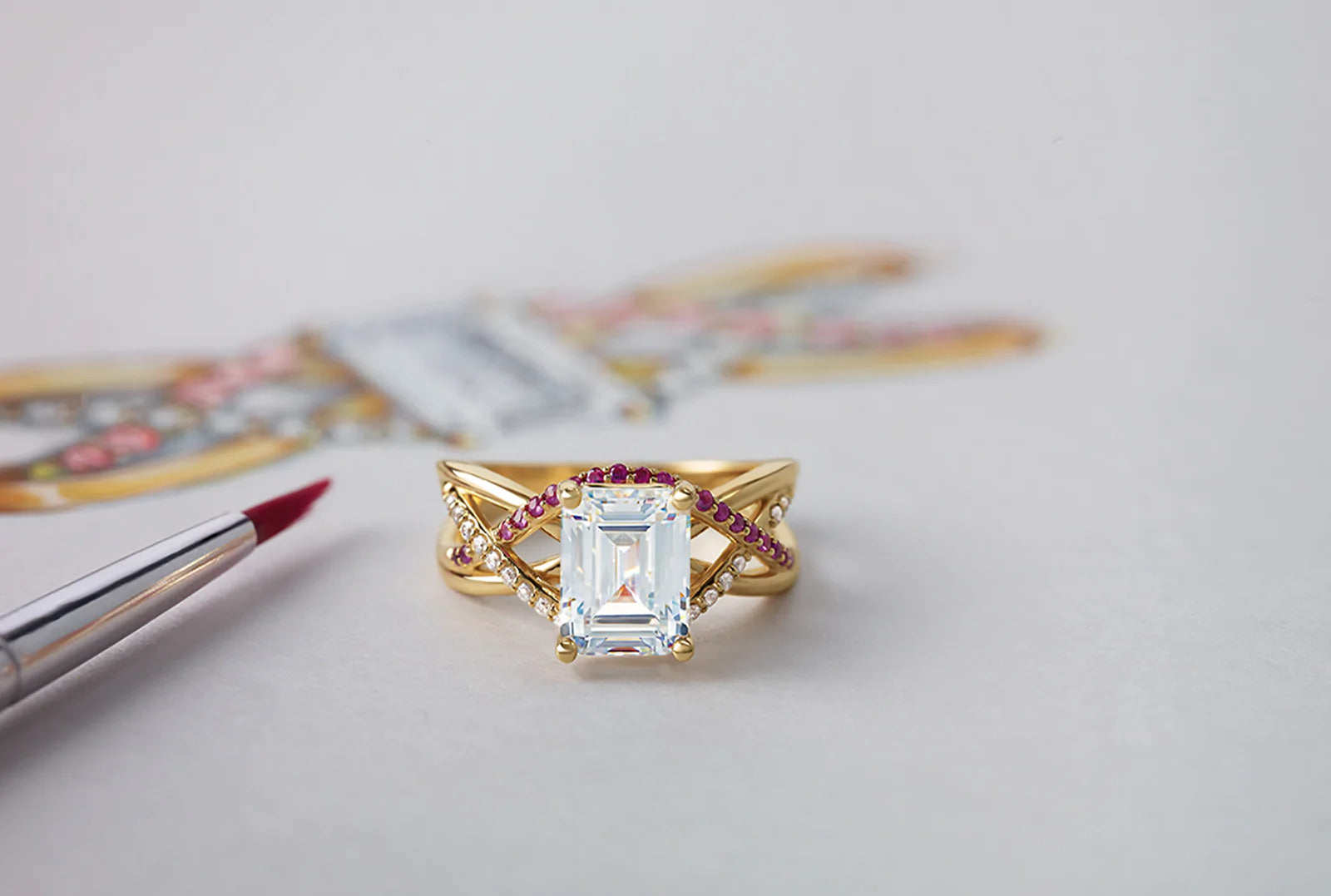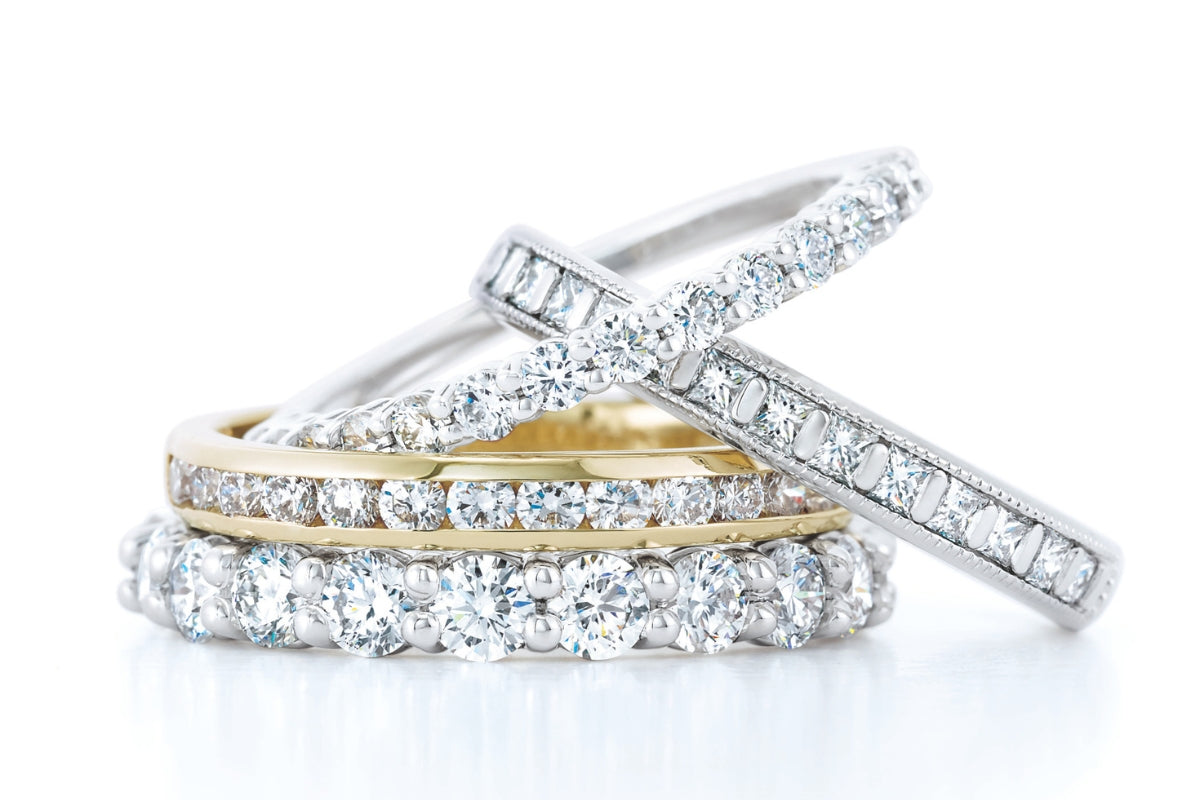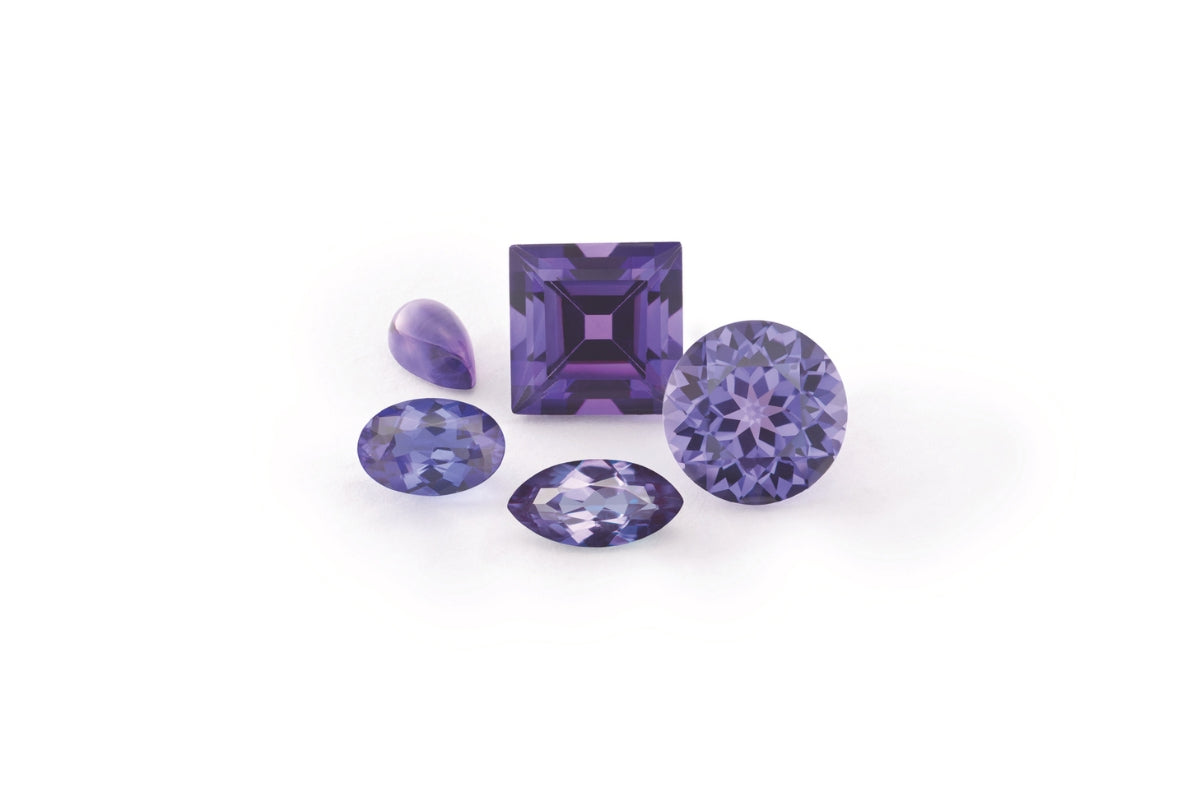The term “anatomy” can sound both scientific and sterile in the world of fashion and fine jewelry. The reality is, taking a few minutes to familiarize yourself with the common components of an engagement ring will certainly help you better understand and appreciate the subtleties when the time comes to either modify or design a custom engagement ring from the ground up. Hence, this is where the anatomy of commonly found engagement ring components and their respective terms come into play. When endeavoring into the world of fine jewelry, you may find pre-made engagement rings, or, an option to create your own custom engagement ring. The latter option can tend to sound a bit overwhelming, but it doesn’t have to be so complicated or expensive. By educating yourself on the major parts of an engagement ring, you’ll be in a better position to knowledgeably shop for and design your dream diamond, colored gemstone, or moissanite engagement ring.
When the time comes to shop for and design your engagement ring, you may be thrown for a loop when you hear terms of which you’re not familiar with. For example, terms like “shank, gallery rail, basket, or prong” are commonly used to describe certain aspects of engagement rings. These terms each refer to a specific part or area that is either optional or integral in the proper execution of an engagement ring. These parts can play an important role not only in the design and overall aesthetic of the piece, but also in the functionality of the interconnected pieces that make up the entirety of the ring. Learning more about these parts will serve you well so you’re not thrown for a loop when the time comes to customize your dream engagement ring.
Let’s investigate the “anatomy” of an engagement ring: its many parts, pieces, and elements so you’re best prepared and can further appreciate the intricacy and craftsmanship associated with the aesthetics of the finished piece.
Let’s begin by defining the anatomy of the engagement ring from top to bottom. Please see the diagram below for reference.

The“head” is quite literally as it sounds, it’s the most noticeable and centralized portion of the ring. It is known to set the primary design language of the ring. Its primary responsibility is to house, safeguard, and present the center stone(s) for the world to see. It can be referred to as the “crown” or “top” of the ring. The head's outline or shape is heavily inspired by the shape (outline) of the chosen center stone(s). The head seats and holds the center stone in place most commonly by way of a “bezel” or “prong” setting style. A “bezel” setting is when the precious metal fully encapsulates the “girdle” or edge of the center stone without the use of a traditional “prong.”
The“prong” refers to the individually notched bars which quite literally hold the center stone(s) by way of grip. A prong's gripping power comes from the carefully crafted notch in each prong. A stone's girdle (edge) is then carefully set inside this groove or lip. Tension is then used to firmly secure the center stone(s), side stone, or accent stones by way of bending each prong to the respective secure position. Though front and center, a prong's influence can be either primary or secondary, depending on the type, color, quantity, and design of the said prong. The prongs act as the primary line of defense in securing the stone in place. Its responsibility is to safely hold and protect the center stone from falling out and depending on the prong type, can help minimize and protect the center stone from normal wear and tear and potential trauma the ring may face. When your finger/hand bumps into something, generally the prongs take the brunt of the abuse. Some people refer to the accent stone prong type or placement as “prong set” for short. Other prong setting styles can lend additional subtle design character. Due to the many variations of prongs, their overall shape and style can vary significantly piece-by-piece and are mainly dictated by the quantity, size, or shape of the stones they are holding.

The“basket”is an extension of the head, found underneath the center stone. It’s generally considered a secondary design element due to it only being noticeable to the wearer of the ring when they “tilt” their wrist into view. The basket can be a good opportunity to either help mask or enhance the color of the center stone. For example, an engagement ring could be in 18K yellow gold, while the “basket” could be in platinum, thus minimizing the yellow gold's direct influence on the colorless centerstone. Its responsibility is to further support the head by way of interconnecting the prongs to lend further structure and stability while housing the centerstone. Sometimes, it can be referred to as the “head” in its entirety. The basket can be a subtle way to accentuate the centerstone(s) by way of decoration with either a combination of accent stone(s), scroll work, or other various design elements.
The“center stone” is most recognizable due to it commonly being the largest stone in a ring. Traditionally, the center stone is a diamond, colored gemstone, or moissanite that’s on display and center of attention. There are different types of setting styles that the centerstone may be featured in. For example, if the ring is a “solitaire,” the center stone is the one and only stone. If the ring is an “accented solitaire”, that means that the centerstone is complemented by “accent” stones on the band of the ring. If it’s a “halo” or “double halo,” the center stone is surrounded by a “halo” made up of either accent stones and/or precious metal. The center stone’s influence on the ring is striking and immediate, usually giving the first impression of the ring from both the wearer and viewer's perspective. Therefore, it’s the leading design feature and element of any ring and tends to set the tone of the overall style of the ring. Its responsibility is to “showcase” the beauty of the various aspects of the center stone chosen. For example, if it’s a diamond, it would display the stone's shape (outline), brilliance and fire of the stone for the world to see. The center stone is commonly referred to as the “star” of the show. It’s very common for rings to showcase the centerstone, regardless of stone type, color, or size. The center stone is usually elevated for many reasons, some being to enhance light performance from all angles, perceived size, and further differentiation in the ring.

The“side stones” are generally the second largest stone immediately flanking the center stone. For a three stone ring, it’s the stone immediately to the left and to the right of the centerstone. There’s no hard rule on the size, shape, or type of side stones that need to be used. Sometimes you’ll find designs that have all three stones matching, making it a traditional “three-stone” ring. The responsibility of the side stones are to complement and further enhance the beauty of the center stone by way of either matching like mentioned above or by being a different gemstone type all together, or simply the same type of stone, but with a slightly different shape, size, or color.
The“gallery” or“gallery rail/bearing” is a feature that not every ring has, but when seen, it is located under the center stone and is commonly the bar that connects the prongs to one another. The responsibility of a gallery rail is generally function rather than form in terms of providing further stabilization of the prongs in case one gets compromised. When seen, it can add a level of cohesiveness to the piece as it usually fills a negative space when further reinforcement may be needed by way of connecting the individual prongs to one another, solidifying the head which houses the center stone. It’s a feature of the ring that only the wearer will notice that it’s not noticeable from the “top-down” view when being looked at as it blends in nicely into the piece with intention.
The“shoulder” of the ring is the approximate 10 o’clock and 2 o’clock position of the ring. Its responsibility is to connect the bottom portion of the ring to the top. This area of the ring can vary based on the overall design, in fact, how the shoulders connect to the head itself can vary from one design to another. The shoulders of the ring design can transition the center stone to either the “accent” stones on the band itself or simply the precious metal continuing down the ring. The shoulders can either be uniform in width or taper towards or away from the center stone or head. The shoulder can also be referred to as the “side” of the ring.

The“accent stone” are the stones that quite literally accentuate both the center stone and ring. Commonly, you’ll find the primary responsibility of the accent stones is to further compliment the center stone by enhancing the overall look and feel of the ring. Many times, accent stones portray a trail leading up to or away from the center stone. The accent stones (like the shoulder above) can also taper towards or away from the center stone or head. The added aesthetic value when the accent stones are shown lend to a cohesive look and feel to the shoulder area or sides of the ring. Accent stones can vary by type, quantity, size, and placement. Typically, accent stones are usually measured by their dimensions, mainly diameter in millimeters as opposed to carats (weight) like center stones.
The“bridge” refers to the connection under the head and between the shoulders for reinforcement and stability of the rings structural integrity.
The“hallmark/engraving”can also be referred to as a“quality mark” and refers to the precious metal quality stamp inside the ring. It’s usually a stamping, etching, or laser inscription. The size and placement is usually small and inconspicuous as its intention is not to draw attention. Common hallmarks are stamped with 14K or 585 which both refer to the karatage of gold being approximately 58% gold content, while 18K or 750 refers to the karatage of gold being approximately 75% gold content. 925 or STER refers to Sterling Silver. 950 or PLAT refers to Platinum. You may find The hallmark may also accompany a jeweler or manufacturer logo. Optionally and if space allows for an engraving, a limited number of characters can be similarly placed inside the ring.
The“shank” generally refers to the upper, side, or more commonly bottom portion of the ring from approximately the 9 o’clock to 3 o’clock position and downward. The shank can also be referred to as the “bottom” of the ring. It’s the portion of the ring that normally gets the most wear-and-tear as it’s constantly interacting with door handles and other items that your finger and palms come into contact with. Some heirloom rings which have been worn for many years will show moderate to heavy wear and thinning around the bottom or 6 o’clock position as most precious metals (other than platinum) tend to wear slowly over time. It’s influence on the ring is subtle as only the wearer of the ring can/will see the shank area when turning their hand over, palm up. The responsibility of the shank is to “complete” the ring design and can feature either precious metals or stones extending from the shoulders down to the bottom shank area. Similar to the shoulders, the shank can either be uniform in width or taper towards or away from the centerstone or head.
The“sizing area” is a small portion of the ring designated to future finger resizing needs. This area of the ring is technically a part of the shank and is located at the bottom of the ring at approximately 7 o’clock to 5 o’clock. To be a true sizing area, this section of the ring would need to be free of any accent stone or intricate design detail as this area allows for the precious metal to be worked in either direction if and when resizing is needed. Having accent stones or intricate design details makes resizing the ring either impossible or will alter the intricacy of the design detail after a sizing repair is made. Having this area of the rings shank free from accent stones and design elements ensures that there is enough room to access the precious metal area needed to complete the process of resizing the ring. This space allows the future bench jeweler and craftsmen the opportunity to reform and reshape the area of the ring to accomplish the increase or decrease of the finger size adjustment.



